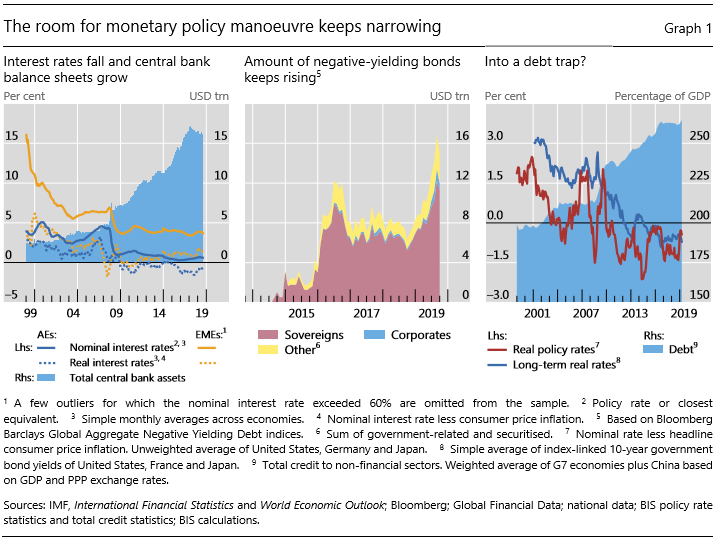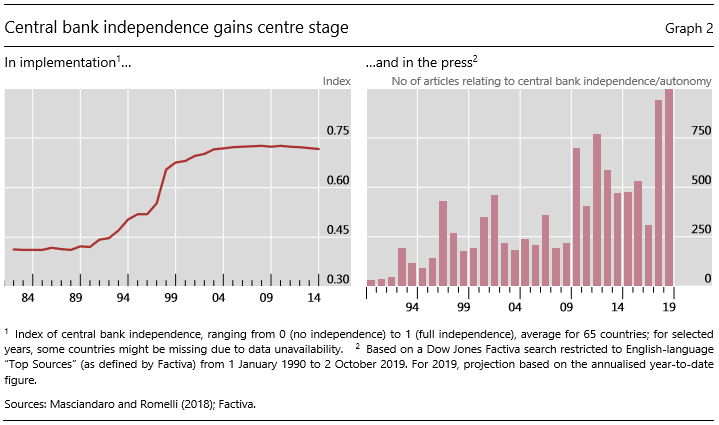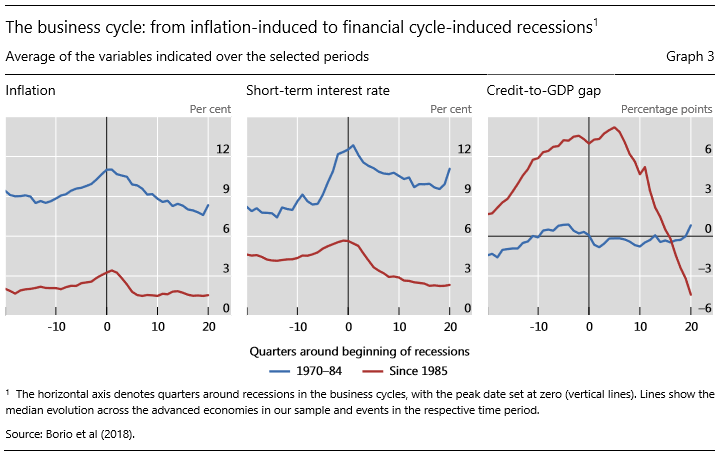References
Acemoğlu, D, S Johnson, P Querubín and J Robinson (2008): “When does policy reform work? The case of central bank independence”, NBER Working Papers, no 14033.
Aldasoro, I, S Avdjiev, C Borio and P Disyatat (2019): “Global and domestic financial cycles: variations on a theme”, BIS Working Papers, forthcoming.
Alesina, A and A Stella (2010): “The politics of monetary policy”, NBER Working Papers, no 15856, April.
Alesina, A and L Summers (1993): “Central bank independence and macroeconomic performance: some comparative evidence”, Journal of Money, Credit and Banking, vol 25, no 2, pp 151–62.
Alquist, R and B Chabot (2011): “Did gold-standard adherence reduce sovereign capital costs?”, Journal of Monetary Economics, vol 58, pp 262–72.
Amaral, P (2017): “Monetary policy and inequality”, Federal Reserve Bank of Cleveland, Economic Commentary, no 2017-01, 10 January.
Ampudia, M, D Georgarakos, J Slačálek, O Tristani, P Vermeulen and G Violante (2018): “Monetary policy and household inequality”, ECB Working Papers, no 2170, July.
Apaitan, T, P Disyatat and P Manopimoke (2018): “Thai inflation dynamics: a view from micro CPI data”, Puey Ungphakorn Institute for Economic Research Discussion Papers, no 85.
Atkeson, A and P Kehoe (2004): “Deflation and depression: is there an empirical link?”, American Economic Review, vol 94, no 2, May, pp 99–103.
Auer, R, C Borio and A Filardo (2017): “The globalisation of inflation: the growing importance of global value chains”, BIS Working Papers, no 602, January.
Bade, R and M Parkin (1988): “Central bank laws and monetary policies”, University of Western Ontario, mimeo.
Banerjee, R and B Hofmann (2018): ”The rise of zombie firms: causes and consequences”, BIS Quarterly Review, September, pp 67–78.
Bank for International Settlements (2018): Annual Economic Report 2018, June, Basel.
——— (2019a): Quarterly Review, September, Basel.
——— (2019b): Annual Economic Report 2019, June, Basel.
Barr, M (2015): “Accountability and independence in financial regulation: checks and balances, public engagement, and other innovations”, Law & Contemp. Probs., vol 78, no 3, pp 119–28.
Barro, R and D Gordon (1983): “A positive theory of monetary policy in a natural rate model”, Journal of Political Economy, vol 91, pp 589–610.
Bartsch, E, M Boivin, S Fischer and P Hildebrand (2019): “Dealing with the next downturn: from unconventional monetary policy to unprecedented policy coordination”, Macro and Market Perspectives, Blackrock Investment Institute, August.
Basel Committee on Banking Supervision (2006): Core Principles for Effective Banking Supervision, updated version of the original from 1997.
Bernanke, B (2002): “On Milton Friedman’s ninetieth birthday”, remarks at the conference in honour of Milton Friedman, University of Chicago, 8 November.
Blanchard, O (2008): “The state of macro”, NBER Working Papers, no 14259, August.
Bloomberg (2018): “All around the world, central bank independence is under threat”, article by A Nag, R Vollgraaff and W Brandimarte, 10 December.
Bordo, M and A Redish (2004): “Is deflation depressing: evidence from the Classical Gold Standard”, in R Burdekin and P Siklos (eds), Deflation: current and historical perspectives, Cambridge University Press.
Bordo, M and H Rockoff (1996): “The gold standard as a ‘good housekeeping’ seal of approval”, The Journal of Economic History, vol 56, no 2, pp 389–428.
Borio, C (2011): “Central banking post-crisis: what compass for uncharted waters?”, in The future of central banking, Central Banking Publications, 2011. Also available as BIS Working Papers, no 353, September 2011.
——— (2014a): “The financial cycle and macroeconomics: what have we learnt?”, Journal of Banking & Finance, vol 45, August, pp 182–98. Also available as BIS Working Papers, no 395, December 2012.
——— (2014b): “Monetary policy and financial stability: what role in prevention and recovery?”, Capitalism and Society, vol 9, no 2, article 1. Also available as BIS Working Papers, no 440, January 2014.
——— (2017): “Through the looking glass”, OMFIF City Lecture, London, 22 September.
——— (2019): “On money, debt, trust and central banking”, Cato Journal, vol 39, no 2, pp 267–302. Also available, slightly expanded, as BIS Working Papers no 763, January 2019.
Borio, C and P Disyatat (2010): “Unconventional monetary policies: an appraisal”, The Manchester School, vol 78, no 1, pp 53–89. Also available as BIS Working Papers, no 292, November 2009.
Borio, C, P Disyatat, M Juselius and P Rungcharoenkitkul (2019): “Monetary policy in the grip of a pincer movement”, in A Aguirre, M Brunnermeier and D Saravia (eds), Monetary policy and financial stability: transmission mechanisms and policy implications, Central Bank of Chile. Also available as BIS Working Papers, no 706, March 2018.
Borio, C, P Disyatat and A Zabai (2016): “Helicopter money: the illusion of a free lunch”, VoxEU, CEPR Policy Portal, 24 May.
Borio, C, M Drehmann and D Xia (2018): “The financial cycle and recession risk”, BIS Quarterly Review, December, pp 59–71.
——— (2019): “Predicting recessions: financial cycle versus term spread”, BIS Working Papers, no 818, October.
Borio, C, M Erdem, A Filardo and B Hofmann (2015): “The costs of deflations: a historical perspective”, BIS Quarterly Review, March, pp 31–54.
Borio, C, E Kharroubi, C Upper and F Zampolli (2015): “Labour reallocation and productivity dynamics: financial causes, real consequences”, BIS Working Papers, no 534, December.
Borio, C and G Toniolo (2008): “One hundred and thirty years of central bank cooperation: a BIS perspective”, in C Borio, G Toniolo and P Clement (eds), The past and future of central bank cooperation, Cambridge University Press. Also available as BIS Working Papers, no 197, February 2006.
Borio, C and H Zhu (2012): “Capital regulation, risk-taking and monetary policy: a missing link in the transmission mechanism?”, Journal of Financial Stability, vol 8, no 4. Also available as BIS Working Papers, no 268, December 2008.
Bourguignon, F (2016): “Inequality and globalization”, Foreign Affairs, January/February 2016 issue, <https://www.foreignaffairs.com/articles/2015-12-14/inequality-and-globalization>, last accessed on 2 January 2017.
Buiter, W (2014): “The simple analytics of helicopter money: why it works – always”, Economics, vol 8, 2014-28, August.
Caballero, R (2010): “Macroeconomics after the crisis: time to deal with the pretense-of-knowledge syndrome”, Journal of Economic Perspectives, vol 24, no 4, pp 85–102.
Carstens, A (2018): “Central banking: trending and cycling”, panel remarks at Sveriges Riksbank’s 350th anniversary conference on 350 years of central banking: the past, the present and the future, Stockholm, 25 May.
——— (2019): “Time to ignite all engines“, speech on the occasion of the BIS Annual General Meeting, Basel, 30 June.
Casiraghi, M, E Gaiotti, L Rodano and A Secchi (2018): “A ‘reverse Robin Hood’? The distributional implications of non-standard monetary policy for Italian households”, Journal of International Money and Finance, vol 85, July, pp 215–35.
Cavallo, A (2018): “More Amazon effects: online competition and pricing behaviors”, NBER Working Papers, no 25138.
Committee on the Global Financial System (2018): “Financial stability implications of a prolonged period of low interest rates”, CGFS Papers, no 61, July.
Cukiermann, A (1992): Central bank strategy, credibility and independence: theory and evidence, MIT Press.
Debelle, G and S Fischer (1994): “How independent should a central bank be?”, in C Fuhrer (ed), Goals, guidelines, and constraints facing monetary policymakers, Federal Reserve Bank of Boston, pp 195–221.
de Haan, J and J Klomp (2008): “Inflation and central bank independence: a meta regression analysis”, Paolo Baffi Centre Research Paper Series, no 2008-03.
Derviş, K (2016): “Time for helicopter money?”, Project Syndicate, 3 March.
Disyatat, P (2008): “Monetary policy implementation: misconceptions and their consequences”, BIS Working Papers, no 269, December.
Domanski, D, M Scatigna and A Zabai (2016): “Wealth inequality and monetary policy”, BIS Quarterly Review, March, pp 45–64.
Drake, P (1989): The money doctor in the Andes: the Kemmerer missions, 1923–33, Durham, NC.
The Economist (2019): “The independence of central banks is under threat from politics”, Leaders section, 13 April.
Edge, R and N Liang (2017): “New financial stability governance structures and central banks”, Hutchins Center Working Papers, no 32, August.
Eichengreen, B (2017): “Central banks in the dock”, Project Syndicate, commentary, 10 November.
Eichengreen, B and K Mitchener (2004): “The Great Depression as a credit boom gone wrong”, Research in Economic History, vol 22, pp 183–237. Also available as BIS Working Papers, no 137, September.
El Erian, M (2016): The only game in town, Random House Publishing Group, January.
Flandreau, M, J Le Cacheux and F Zumer (1998): “Stability without a pact? Lessons from the European gold standard, 1880–1914”, Economic Policy, vol 13, no 26, pp 115–62.
Flandreau, M and F Zumer (2004): The making of global finance, 1880–1913, OECD.
Forbes, K (2019): “Has globalisation changed the inflation process?”, BIS Working Papers, no 791, July.
Friedman, M (1962): “Should there be an independent monetary authority?”, in L Yaeger (ed), In search of a monetary constitution, Cambridge: Harvard University Press, pp 219–43.
——— (1969): “The optimum quantity of money”, Chapter 1 in M Friedman, The optimum quantity of money and other essays, Adline Publishing Company.
Fukuyama, F (2002): The end of history and the last man, Free Press.
Giannini, C (2011): The age of central banks, Edward Elgar.
Goodhart, C (2011): “The changing role of central banks”, BIS Working Papers, no 326, November.
Goodhart, C and P Delargy (2002): “Financial crises: plus ça change, plus c’est la même chose”, International Finance, vol 1, no 2, pp 261–87.
Goodhart, C and R Lastra (2017): “Populism and central bank independence”, Discussion Paper Series, DP12122.
Goodhart, C and D Schoenmaker (1995): “Should the functions of monetary policy and banking supervision be separated?”, Oxford Economic Papers, vol 47, pp 539–60.
Greenspan, A (1994): Testimony before the Subcommittee on Economic Growth and Credit Formation of the Committee on Banking, Finance and Urban Affairs, US House of Representatives, 22 February.
——— (2005): “Risk transfer and financial stability”, remarks at the Federal Reserve Bank of Chicago’s Forty-first Annual Conference on Bank Structure, Chicago, 5 May.
Grilli, V, D Masciandaro and G Tabellini (1991): “Political and monetary institutions and public financial policies in industrial countries”, Economic Policy, vol 13, pp 341–92.
Gros, d and F Roth (2009): “The crisis and citizens’ trust in central banks”, VoxEU, 10 September.
Issing, O, V Gaspar, I Angeloni and O Tristani (2001): Monetary policy in the euro area, Cambridge University Press.
James, H (2010): “Central banks between internationalisation and domestic political control”, BIS Working Papers, no 327, November.
King, M (2000): “Monetary policy: theory in practice”, speech, Plymouth, 7 January.
Kydland, F and E Prescott (1977): “Rules rather than discretion: the inconsistency of optimal plans”, Journal of Political Economy, vol 85, pp 473–90.
Lenza, M and J Slačálek (2018): “How does monetary policy affect income and wealth inequality? Evidence from quantitative easing in the euro area”, ECB Working Papers, no 2190, October.
Lévy, R-G (1911): Banques d’émission et trésors publics, Paris: Librairie Hachette.
Löwith, K (1949): Meaning in history, University of Chicago Press.
Masciandaro, D and D Romelli (2018): “Beyond the central bank independence veil: new evidence”, Bocconi Working Paper Series, no 71, January.
Masciandaro, D, M Quintyn and M Taylor (2008): “Financial supervisory independence and accountability – exploring the determinants”, IMF Working Papers, WP/08/147, June.
Masciandaro, D and A Volpicella (2016): “Macro prudential governance and central banks: facts and drivers”, Journal of International Money and Finance, vol 61, pp 101–19.
McCallum, B (1995): “Two fallacies concerning central bank independence”, NBER Working Papers, no 5075.
Mehrling, P (2011): The New Lombard Street: how the Fed became the dealer of last resort, Princeton University Press.
Miles, D, U Panizza, R Reis and A Ubide (2017): “And yet it moves – inflation and the Great Recession: good luck or good policies?”, Geneva Report on the World Economy, no 19, International Center for Monetary and Banking Studies, CEPR.
Neuenkirch, M and M Nöckel (2018): “The risk-taking channel of monetary policy in the euro area”, Journal of Banking and Finance, online.
Nordhaus, W (1975): “The political business cycle“, Review of Economic Studies, vol 42, no 2, pp 169–90.
Obstfeld, M and A Taylor (2003): “Sovereign risk, credibility and the gold standard: 1870–1913 versus 1925–31”, Economic Journal, vol 113, pp 241–75.
Padoa-Schioppa, T and F Saccomanni (1994): “Managing a market-led global financial system”, in Managing the world economy: fifty years after Bretton Woods, Washington DC, IIE, pp 235–68.
Parkin, M (2013): “The effects of central bank independence and inflation targeting on macroeconomic performance: evidence from natural experiments”, Economic Policy Research Institute EPRI Working Paper Series, June.
Passacantando, F (2013): “Challenging times for central bank independence”, speech at the World Bank Treasury Reserves Advisory and Management Program Executive Forum for Policymakers and Senior Officials, Washington DC, April.
Posen, A (1998): “Central bank independence and disinflationary credibility: a missing link?”, Oxford Economic Papers, vol 50, no 3, pp 335–59.
Quintyn, M and W Taylor (2003): “Regulatory and supervisory independence and financial stability”, CESifo Economic Studies, vol 49, pp 259–94.
Rajan, R (2015): Panel remarks at the IMF Conference, Rethinking Macro Policy III, Washington DC, 15–16 April.
——— (2017): “Central banks’ year of reckoning”, Project Syndicate, 21 December.
Reis, R and M Watson (2010): “Relative goods’ prices, pure inflation and the Phillips correlation”, American Economic Journal: Macroeconomics, vol 2, no 3, pp 128–57.
Rey, H (2013): “Dilemma not trilemma: the global financial cycle and monetary policy independence”, paper presented at the Federal Reserve Bank of Kansas City Economic Policy Symposium on Global dimensions of unconventional monetary policy, Jackson Hole, 22–24 August.
Rogoff, K (1985): “The optimal degree of commitment to an intermediate monetary target”, Quarterly Journal of Economics, vol 100, no 4, pp 1169–89.
Romer, P (2016): “The trouble with macroeconomics”, The American Economist, forthcoming.
Rosenberg, E (1999): Financial missionaries to the world: the politics and culture of dollar diplomacy, 1900–30, Harvard.
Rungcharoenkitkul, P, C Borio and P Disyatat (2019): “Monetary policy hysteresis and the financial cycle”, BIS Working Papers, no 817, October.
Sayers, R (1976): The Bank of England 1891–1944, Appendices, Cambridge University Press.
Shaikh, B (2017): “Retreat of globalisation: central banks in the crosshairs”, Gateway House, 14 February.
Smets, F (2013): “Financial stability and monetary policy: how closely interlinked?”, Sveriges Riksbank, Economic Review, vol 3, Special Issue, pp 121–59.
Svensson, L (1999): “Monetary policy issues for the eurosystem”, Carnegie-Rochester Conferences Series on Public Policy, vol 51, no 1, pp 79–136.
Taylor, J (2010): “Macroeconomic lessons from the Great Deviation”, remarks at the 25th NBER Macro Annual Meeting, May.
Toniolo, G (ed) (1988): Central banks’ independence in historical perspective, Walter de Gruyter.
Toniolo, G (2010): “What is a useful central bank? Lessons from the interwar years”, Oslo, 18 November.
Turner, A (2015): “The case for monetary finance – an essentially political issue”, paper presented at the Sixteenth Jacques Polak Annual Research Conference, IMF.
Tucker, P (2018): Unelected power: the quest for legitimacy in central banking and the regulatory state, Princeton University Press.
Vickers, J (2010): “Central banks and competition authorities: institutional comparisons and new concerns”, BIS Working Papers, no 331, November.
Vico, G (1744): Principii di Scienza Nuova, Stamperia Giuziana. English translation: The new science, 1948, Cornell University Press.
Volcker, P (2018): Keeping at it: the quest for sound money and good government, Hachette Book Group.
Woodford, M (2003): Interest and prices, Princeton University Press.
Wray, R (2015): Modern money theory, second edition, Palgrave MacMillan.






